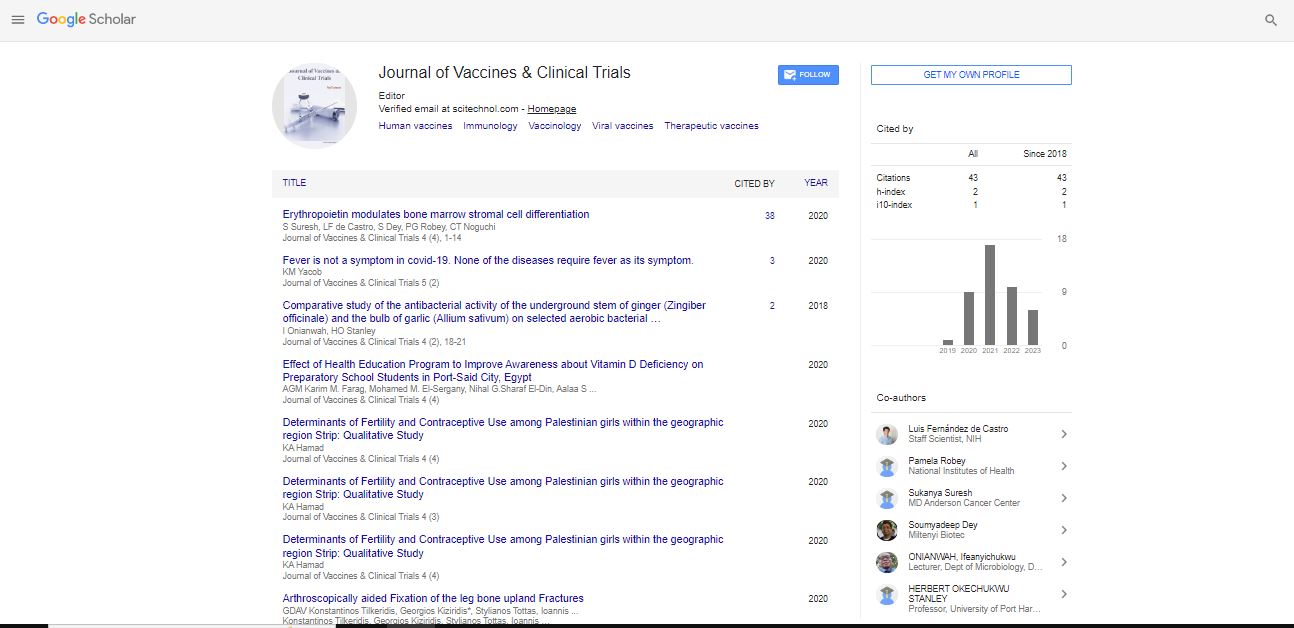Opinion Article, Jou Of Vac Cli Tr Vol: 7 Issue: 4
An Overview on Mycobacterium tuberculosis and its Prevention Methods
Joshua Seidu*
1Department of Infectious Diseases, Kwame Nkrumah University of Science and Technology, Kumasi, Ghana
*Corresponding Author: Joshua Seidu,
Department of Infectious Diseases,
Kwame Nkrumah University of Science and Technology, Kumasi, Ghana
E-mail: seiduseidu@knust.edu.gh
Received date: 27 November, 2023, Manuscript No. JVCT-24-128361;
Editor assigned date: 30 November, 2023, PreQC No. JVCT-24-128361 (PQ);
Reviewed date: 07 December, 2023, QC No. JVCT-24-128361;
Revised date: 21 December, 2023, Manuscript No. JVCT-24-128361 (R);
Published date: 28 December, 2023 DOI: 10.4172/JVCT.100091
Citation: Seidu J (2023) An Overview on Mycobacterium tuberculosis and its Prevention Methods. Jou of Vac Cli Tr 7:4.
Description
Mycobacterium tuberculosis, often abbreviated as M. tuberculosis, is an aerobic, rod-shaped bacterium that primarily affects the lungs but can also invade other parts of the body, causing Tuberculosis (TB).
M. tuberculosis is characterized by a unique, thick, lipid-rich cell wall that contributes to its resilience and ability to resist environmental stressors and immune system attacks. This bacterium has a slow growth rate, requiring specialized laboratory techniques for culturing and identification.
TB is mainly transmitted through the air when an infected individual coughs, sneezes, or talks, releasing infectious droplets containing the bacterium. Close and prolonged contact with an infected person poses a higher risk of transmission, although not everyone exposed to TB bacteria develops active disease.
Upon inhalation, M. tuberculosis can settle in the lungs and evade the body's immune defenses. In most cases, the immune system can contain the infection, leading to latent TB. However, when the immune system weakens, the bacteria can reactivate, causing active TB disease characterized by symptoms such as cough, fever, weight loss, and fatigue.
TB remains a major global health concern, particularly in low- and middle-income countries with limited access to healthcare resources.
The World Health Organization (WHO) estimates that millions of people contract TB annually, with a significant number succumbing to the disease despite available treatments.
Various diagnostic methods, including skin tests, blood tests, chest X-rays, and molecular tests, help detect TB. These tests aid in identifying both latent TB infection and active TB disease, enabling prompt treatment and management.
TB treatment typically involves a combination of antibiotics taken for an extended period to ensure the complete eradication of the bacteria. However, the rise of drug-resistant strains, including Multidrug-resistant TB (MDR-TB) and Extensively Drug-resistant TB (XDR-TB), poses a significant challenge to effective TB control and requires more prolonged, complex treatment regimens.
Preventive measures include vaccination with the Bacille Calmette- Guérin (BCG) vaccine, which offers variable protection against severe forms of TB in children. Additionally, efforts to improve infection control, increase access to healthcare, and develop new drugs and vaccines are crucial in combating TB.
Continued research into better diagnostic tools, more effective treatments, and a potential TB vaccine remains a priority. Advancements in genomics and immunology have provided valuable insights into the bacterium's behavior and host-pathogen interactions, offering hope for novel interventions.
Beyond its medical implications, TB can carry social stigma due to misconceptions about transmission and lack of awareness. Stigmatization can hinder efforts to diagnose and treat the disease effectively, underscoring the importance of community education and support programs.
Efforts to eliminate TB as a public health threat continue, with global initiatives aiming to reduce TB incidence, mortality, and catastrophic costs associated with the disease. A comprehensive approach encompassing healthcare infrastructure strengthening, research investment and community engagement remains essential.
Mycobacterium tuberculosis and the disease it causes, tuberculosis, have shaped medical history and continue to present formidable challenges in healthcare systems worldwide. Addressing TB requires a multifaceted approach that spans prevention, diagnosis, treatment, and societal awareness to mitigate its impact and eventually eradicate this persistent global health threat.
 Spanish
Spanish  Chinese
Chinese  Russian
Russian  German
German  French
French  Japanese
Japanese  Portuguese
Portuguese  Hindi
Hindi 